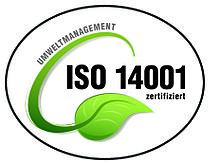ISO 14001
The international environmental management standard ISO 14001 defines globally recognized requirements for an environmental management system and is part of a family of standards. This includes numerous other standards for various areas of environmental management, including life cycle assessments , environmental indicators and environmental performance assessment . It can be applied to both manufacturing and service companies. It is not clear when and if such a check has to be repeated or how long it is valid.
Goal of the norm
The ISO 14001 focuses on a continuous improvement process as a means of achieving the objectives defined in each case in relation to the environmental performance of an organization (company, service, administration, etc.). The continuous improvement process based on the method Plan-Run Check-Optimize (Plan-Do-Check-Act, PDCA):
- Planning: Establishing the goals and processes to achieve the implementation of the organisation's environmental policy.
- Execute: the implementation of the processes.
- Control: Monitoring of the processes with regard to legal and other requirements as well as goals of the environmental policy of the organization; If applicable, publication of the environmental performance (the success of the organization in relation to its environmental protection measures).
- Optimizing: If necessary, the processes must be corrected (adapted).
For this purpose, a company should define an operational environmental policy , environmental goals and an environmental program as well as develop a corresponding management system that helps to achieve the goals. Material flow analysis has proven its worth as a support for describing environmental impacts . The Cleaner Production approach helps to develop options and goals for reducing waste, wastewater and emissions on the basis of the analysis of material and energy flows.
In order to be able to achieve the desired environmental performance, the organization should set up and implement an environmental management system based on its environmental policy (i.e. its objectives with regard to environmental protection) as a first step. Continuous improvement should be achieved through regular reviews of the (environmental) goals set and the environmental management system.
The standard expressly emphasizes that it does not specify any absolute requirements for environmental performance. However, it demands compliance with the obligations that the organization has imposed on itself in its environmental policy. However, and this is new in the revised ISO 14001, you have to promise to comply with applicable legal obligations. However, actual compliance is not required ("Commitment to Compliance" instead of "Compliance" in the original text).
Further development
ISO 14001 was first published by the International Organization for Standardization in 1996 (14001: 1996). On June 16, 2000, a decision was made to revise the standard in Stockholm . Essentially two objectives were pursued with this revision:
- greater compatibility with the quality management standard ISO 9001 and
- the elimination of ambiguities and thus greater user-friendliness
The revised international version ( ISO 14001: 2004 ) was published on November 15, 2004 . In addition to the international version (only available in English), there are other versions of this revised standard, namely the European versions.
European versions
|
|
DIN EN ISO 14001 |
|---|---|
| Area | Environmental management |
| title | Environmental management systems - requirements with guidance for use |
| Latest edition | 11.2015 |
| ISO | 14001 |
The EN designation of the respective version of ISO 14001 shows that the standard issued by ISO has been adopted by the European Committee for Standardization (CEN) as a European standard (EN). This means that all members of CEN are obliged to adopt this standard unchanged. In German-speaking countries, these are
- the German Institute for Standardization (DIN) with the DIN standard DIN EN ISO 14001: 2015-11 and ISO 14001: 2015
- the Austrian Standards International (ASI) with ÖNORM EN ISO 14001: 2009-08 and ÖNORM EN ISO 14001: 2009
- the Swiss Association for Standardization (SNV) with SN EN ISO 14001: 2005-01 and SN EN ISO 14001: 2005
The official designation of the standard in bold shows the country-specific year and month of publication. The current German standard DIN EN ISO 14001: 2015-11 was published on November 1st, 2015.
Certification
The certification is carried out by accredited certifiers. According to the International Organization for Standardization (ISO), at least 223149 certificates based on the ISO 14001 regulations had been issued in 155 countries internationally by the end of 2009.
See also
literature
- René Gastl: Continuous improvement in environmental management. The CIP requirement of ISO 14001 in theory and business practice . vdf-Verlag, 2nd edition, Zurich 2009, ISBN 3-7281-3034-6
- Bernhard Schwager: Revision of the ISO 14001 standard - New requirements for environmental management systems , Environmental Economic Forum , 2015, 4, doi : 10.1007 / s00550-015-0365-4
- Katharina Wührl, Bernhard Schwager: DIN EN ISO 14001: 2015 - comparison with DIN EN ISO 14001: 2009, changes and effects , German Institute for Standardization eV, Beuth-Verlag, Berlin 2016, ISBN 978-3-4102-5991-6
Web links
- ISO 14001 - environmental management system standard . Website of the Federal Environment Agency.
Individual evidence
- ↑ a b ISO 14000 essentials
- ↑ The ISO Survey of certifications 2009 , 18th edition (2010), ISBN 978-92-67-10535-2 .
